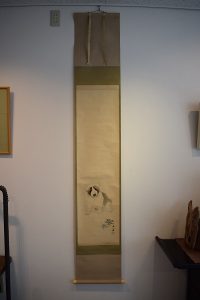川合 玉堂の子犬掛軸が可愛すぎて仕事がはかどります(愛知県名古屋市千種区姫池通 骨董買取 古美術風光舎)
2022.09.19
こんにちは、スタッフNでございます。
先日のスタッフのブログで紹介されていたbohemianvoodooを聞きながら、ブログを書いております。
学生時代に、八ヶ岳に野外映画とパラグライダーをしに行ったことがあるのですが、そんな素敵な音楽堂があることを今まで知らずにおりました。
いつか行ってみたいと思います。
さて、台風も近づいてまいりまして、こちらも風が強くなってまいりました。
先ほど、強風の中散歩している犬がおりまして、飼い主は大変そうでしたが、犬はいつもより強い風に大喜びでございました。
今朝出勤いたしましたら、とても可愛らしい子犬の掛軸がございました。
筆の柔らかい感じと丸々とした体がなんとも言えません。
この子のおかげで、仕事がはかどります。

今日はこちらの子犬の作者の川合 玉堂(かわい ぎょくどう)について調べてまいりました。
1873年〈明治6年〉11月24日 – 1957年〈昭和32年〉6月30日)明治・大正・昭和時代の日本で活動した日本画家でございます。
本名は 川合 芳三郎(かわい よしさぶろう)で、画号は当初「玉舟(ぎょくしゅう)」、間もなく「玉堂」に改め、晩年は終の棲家と同名の「偶庵(ぐあん)」を別号として用いました。
愛知県葉栗郡外割田村(現在の一宮市木曽川町外割田)にて、1873年(明治6年)11月24日、筆墨紙商の長男として生まれます。
なんと、知人の家の近くに、こんな素敵な作家が昔住んでいたとは、運命を感じます。
1881年(明治14年)、一家は岐阜市に移住致します。
絵には12歳頃から親しむようになったといいます。
1886年(明治19年)、京都の画家・青木泉橋が岐阜に来住すると、夫人も翠蘋と号する美人画家で、芳三郎少年は青木夫妻の知遇を得て大いに刺激を受けたそうです。
1887年(明治20年)・14歳を迎える年の9月、青木泉橋の紹介状を持って京都に上り、四条派・望月玉泉の門に入り、「玉舟」の号を得ます。
1890年(明治23年)11月になると円山派・幸野楳嶺の画塾「大成義会」に入り、同年、『春渓群猿図』『秋渓群鹿図』の連作を第3回内国勧業博覧会に出品して早くも入選を果たすと、これを機に「玉堂」に改号致しました。
1896年(明治29年)・23歳の時に上京して(東京へ移住して)橋本雅邦に師事します。
岡倉覚三(天心)、雅邦、横山大観らの創立した日本美術院には1898年(明治31年)当初より参加。
1900年(明治33年)頃からは私塾「長流画塾」を主宰しております。
1907年(明治40年)には第1回文展(第1回文部省美術展覧会。cf 日展#開催歴 )の審査員に任命され、また、1915年(大正4年)からは東京美術学校日本画科教授、1917年(大正6年)6月11日には帝室技芸員に任じられ、日本画壇の中心的存在の一人となります。
1931年(昭和6年)にはフランス政府からレジオンドヌール勲章を授与されました。
1933年(昭和8年)にはドイツ政府から赤十字第一等名誉章を授与されました。
1940年(昭和15年)には日本政府から文化勲章を授与されました。
第二次世界大戦中の1944年(昭和19年)、かねてより写生で頻繁に訪れていた東京都西多摩郡三田村御岳(現・青梅市御岳)に疎開し、住居を「偶庵(ぐあん)」、画室を「随軒(ずいけん)」と称しました。
戦後も同地の自然を愛する玉堂はそのまま定住し、同地にて1957年(昭和32年)6月30日、心臓喘息で死去いたしました。贈・正三位・勲一等旭日大綬章(没時叙勲)。
神奈川県横浜市金沢区には1917年(大正6年)頃に建設した別邸「二松庵」があり、横浜市指定有形文化財として月1回の一般公開もなされていましたが、2013年(平成25年)10月16日に発生した火災で全焼してしまったそうです。
二松庵庭園は2016年(平成28年)11月4日付で横浜市の名勝に指定されました。
日本の四季の山河と、そこで生きる人間や動物の姿を美しい墨線と彩色で描くことを得意とし、玉堂のもとには、長野草風、池田輝方、池田蕉園、松本姿水、山内多門、高橋玉淵、今中素友、田中針水、石渡風古ら多くの門人がおりました。
玉堂は、1944年(昭和19年)から死去する1957年(昭和32年)までを東京都西多摩郡三田村御岳(現・青梅市御岳)で過ごしました。
玉堂の死後、画家がこの地で愛した御岳渓谷に美術館を設置しようという声があがりました。
香淳皇后の支援のもと、諸団体、地元有志、ならびに全国の玉堂ファンから多大な寄付を受け、死後4年を経た1961年(昭和36年)5月に玉堂美術館が開館しました。
玉堂美術館いつか行ってみたいですね。
古美術風光舎では、川合 玉堂など 動物の掛軸も買取致しております。
ではでは

Hello, this is staff N.
A typhoon is approaching, and the wind is getting stronger.
A little while ago, there was a dog walking in a strong wind.
When I went to work this morning, I found a hanging scroll of a very cute puppy.
I can’t say anything about the soft feeling of the brush and the plump body.
Thanks to this child, work progresses.
Today, I have researched about Gyokudo Kawai, the creator of this puppy.
November 24, 1873 (Meiji 6) – June 30, 1957 (Showa 32)) A Japanese-style painter active in Japan during the Meiji, Taisho, and Showa periods.
His real name was Yoshisaburo Kawai, and his painting name was initially “Gyokushu,” but soon changed to “Gyokudo.” I used it as a separate number.
Born on November 24, 1873 (Meiji 6) in Sotowarita Village, Haguri District, Aichi Prefecture (currently Sotowarita, Kisogawa-cho, Ichinomiya City) as the eldest son of a calligrapher and paper merchant.
It feels like fate that such a wonderful writer used to live near my acquaintance’s house.
In 1881 (Meiji 14), his family moved to Gifu City.
It is said that he became familiar with painting from around the age of 12.
In 1886 (Meiji 19), when Izumihashi Aoki, a painter from Kyoto, came to Gifu, his wife was also a beautiful painter called Suiban, and it is said that young Yoshisaburo was greatly inspired by the courtesy of Mr. and Mrs. Aoki. is.
In September of 1887 (Meiji 20), the year he turned 14, he traveled to Kyoto with a letter of introduction from Izumibashi Aoki, entered the gate of Gyokusen Mochizuki of the Shijo school, and received the name ‘Gyokufune.’
In November 1890 (Meiji 23), he entered Taisei Gikai, a painting school of the Maruyama school Kono Bairei, and in the same year completed his third series of paintings, “Shunkei Zaru Zu” and “Shukei Guroku Zu”. After exhibiting at the Industrial Expo and being selected as a winner, we changed the name to “Gyokudo” on this occasion.
In 1896, at the age of 23, he moved to Tokyo and studied under Gaho Hashimoto.
From 1898 (Meiji 31), he participated in the Japan Art Institute founded by Kakuzo Okakura (Tenshin), Gaho, and Taikan Yokoyama.
Since around 1900 (Meiji 33), he has been presiding over the private school “Osaryu Painting School”.
In 1907 (Meiji 40), he was appointed as a judge of the 1st Bunten (the 1st Ministry of Education art exhibition. cf Nitten #Holding history), and from 1915 (Taisho 4) he was appointed as a judge of Tokyo art. He was appointed as a professor at the school’s Japanese painting department, and on June 11, 1917, was appointed as an Imperial Household Artist, becoming one of the central figures in the Japanese painting world.
In 1931, he was awarded the Legion of Honour by the French government.
In 1933 (Showa 8), the German government awarded him the Red Cross First Class Medal of Honor.
In 1940 (Showa 15) he was awarded the Order of Culture by the Japanese government.
In 1944 (Showa 19) during World War II, he evacuated to Mitake, Mitamura, Nishitama-gun, Tokyo (currently Mitake, Ome City), where he had frequently visited for sketching, and moved to Guan. , the studio was called ‘Zuiken’.
Even after the war, Gyokudo, who loved the nature of the area, settled there and died of heart asthma on June 30, 1957 (Showa 32). He received the Grand Cordon of the Rising Sun, the Order of the Rising Sun, the First Third Rank, and the Order of the Rising Sun (conferred at the time of his death).
In Kanazawa Ward, Yokohama City, Kanagawa Prefecture, there is a villa “Nishoan” that was built around 1917 (Taisho 6), and it was opened to the public once a month as a Yokohama City Designated Tangible Cultural Property, but in 2013 ( Heisei 25) It seems that it was completely destroyed by the fire that occurred on October 16th.
Nishoan Garden was designated as a scenic spot of Yokohama City on November 4, 2016.
He specializes in depicting the mountains and rivers of Japan in four seasons and the figures of humans and animals that live there with beautiful ink lines and colors. , Tamabuchi Takahashi, Sotomo Imanaka, Harimizu Tanaka, and Fuko Ishiwatari.
From 1944 until his death in 1957, Gyokudo lived in Mitake, Mitamura, Nishitama-gun, Tokyo (now Mitake, Ome City).
After the death of his Gyokudo, there were calls to establish an art museum in the Mitake Valley, which the artist loved in this area.
With the support of Empress Kojun, the Gyokudo Museum opened in May 1961, four years after his death, with a large amount of donations from various groups, local volunteers, and Gyokudo fans nationwide. .
I would love to visit the Gyokudo Museum someday.
At Antique Fukousha, we also purchase hanging scrolls of animals such as Gyokudo Kawai.
See you soon
*********************
ご実家の整理やお片付けなどをされている方のご相談などが多くございます。朝晩少し涼しい季節となってまりましたが、でくれぐれもご無理のないようになさってくださいませ。風光舎では古美術品や骨董品の他にも絵画や宝石、趣味のお品など様々なジャンルのものを買受しております。
お片付けをされていて、こういうものでもいいのかしらと迷われているものでも、どうぞお気軽にご相談下さいませ。
また風光舎は、出張買取も強化しております。ご近所はもちろん、愛知県内、岐阜県、三重県その他の県へも出張いたします。
まずは、お電話お待ちしております。
愛知県名古屋市千種区・骨董 買取
『古美術 風光舎 名古屋店』
TEL052(734)8444
10:00-17:00 OPEN
#川合玉堂 #犬 #掛軸 #古美術風光舎 #骨董

